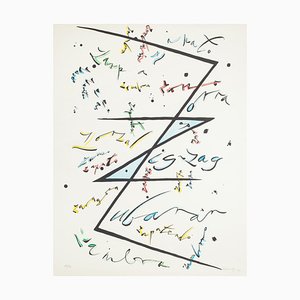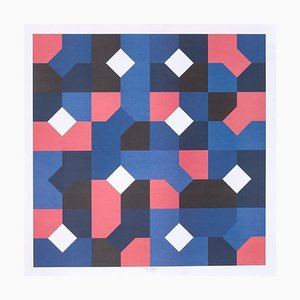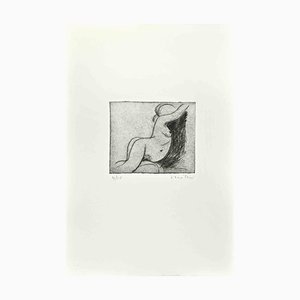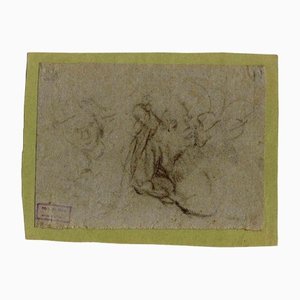Veni, domine Iesu (The Spirit is willing, but the flesh is weak) is an artwork realized in 1964. It is part of Biblia Sacra vulgatæ editionis published by Rizzoli-Mediolani between 1967 and 1969. Color lithograph on heavy rag paper. Signed and dated on plate on the lower right margin. Perfect conditions. The title of this artwork refers to a verse of the Book of Revelations; in the representation we find a central shape with a big brown cross and some stylized figures on the lower margin. The composition is very simple but there is a sense of majesty and greatness. The lithograph is part of the imponent work Biblia Sacra vulgatæ editionis published by Rizzoli-Mediolani between 1967 and 1969. It was illustrated by Salvador Dalí with a suite of 105 colored lithographs after water-color artworks. The paper sheets are signed and dated on plate, and each of them comes with a Japanese paper tissue with a printed biblical quotation. The works also demonstrate Dalí’s artistic spontaneity in the use of the “bulletism” technique, a Dalinian invention where an arquebus (a type of ancient gun) is loaded with ink-filled capsules and then fired against blank sheets of paper. In 1963, Biblia Sacra was commissioned by Giuseppe Albaretto, a very pious man, who was one of Dalí’s closest friends and patrons between the 1950s and the 1960s. Giuseppe Albaretto and his wife Mara commissioned several of Dalí's works, and became important publishers of his etchings and lithographs, including the Biblia Sacra. Through these commissions, Albaretto hoped that Dalí would reconcile with religion. The friendship between the Albarettos and Salvador Dalí provided the art world with some of the most spectacular Surrealist artworks. These works are a few of the most desirable graphic works ever created by the artist. In the preface of the work, the publisher asserts that the lithographs “configure, in both a universal and a personal way, the dynamic vision that characterizes the relationship between men and God”. Salvador Dalí (Figueres, 1904 – Figueres, 1989) is considered one of the most versatile and prolific artists of the XX century and the founding father of Surrealism. In the course of his long career, he successfully experimented with sculpture, fashion, writing, and filmmaking. In his early use of organic morphology, his work bears the stamp of Pablo Picasso and Joan Miró. His work is also characterized by a fascination with classical art, manifested in the realistic style and religious symbolism of his latest works. Dalí was born near Barcelona to a middle class family. He soon demonstrated an interest in art, and, at the age of 18, he attended the Special Painting, Sculpture and Engraving School of San Fernando in Madrid. His eccentricity was notorious, and at first even more famous than his works. When he traveled to Paris, he met Pablo Picasso in his studio and took inspiration from Cubism. In 1928, he collaborated with Buñuel on Un Chien Andalou, which eventually became a manifest of Surrealism. Surrealists considered recruiting Dalí into their circle. In the next years, Dalí’s paintings illustrated his theories about paranoia. He painted bodies, corps, objects that reflected sexuality, anxiety and fear. In the 1950s, Dalí’s paintings focused on religious themes reflecting his interest in the supernatural. During that period, he stayed at the St. Regis hotel, where he met Andy Warhol, another eccentric personality that was considered a modern influence for the setting Dalí produced earlier. Dalí epitomizes the idea that life is the greatest form of art; André Breton said about him: “It is with Dalí that, for the very first time, the windows of the mind are wide open”.




















Get in Touch
Make An Offer
We noticed you are new to Pamono!
Please accept the Terms & Conditions and Privacy Policy
Get in Touch
Make An Offer
Almost There!
To follow your conversation on the platform, please complete the registration. To proceed with your offer on the platform, please complete the registration.Successful
Thanks for your inquiry, someone from our team will be in touch shortly
If you are a Design Professional, please apply here to get the benefits of the Pamono Trade Program